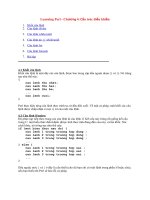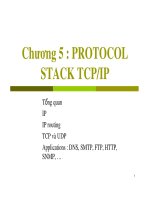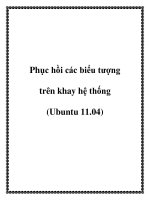04 chuong tcp 2
Bạn đang xem bản rút gọn của tài liệu. Xem và tải ngay bản đầy đủ của tài liệu tại đây (645.93 KB, 22 trang )
Understanding the
TCP/IP Transport
Layer
Building a Simple Network
© 2007 Cisco Systems, Inc. All rights reserved.
ICND1 v1.0—1-1
Transport Layer
Session multiplexing
Segmentation
Flow control (when required)
Connection-oriented
(when required)
Reliability (when required)
© 2007 Cisco Systems, Inc. All rights reserved.
ICND1 v1.0—1-2
Reliable vs. Best-Effort Comparison
© 2007 Cisco Systems, Inc. All rights reserved.
ICND1 v1.0—1-3
UDP Characteristics
Operates at transport layer of OSI and TCP/IP models
Provides applications with access to the network layer without the
overhead of reliability mechanisms
Is a connectionless protocol
Provides limited error checking
Provides best-effort delivery
Has no data-recovery features
© 2007 Cisco Systems, Inc. All rights reserved.
ICND1 v1.0—1-4
UDP Header
© 2007 Cisco Systems, Inc. All rights reserved.
ICND1 v1.0—1-5
TCP Characteristics
Transport layer of the TCP/IP stack
Access to the network layer for applications
Connection-oriented protocol
Full-duplex mode operation
Error checking
Sequencing of data packets
Acknowledgement of receipt
Data-recovery features
© 2007 Cisco Systems, Inc. All rights reserved.
ICND1 v1.0—1-6
TCP Header
© 2007 Cisco Systems, Inc. All rights reserved.
ICND1 v1.0—1-7
TCP/IP Application Layer Overview
File transfer
– FTP
– TFTP
– Network File System
– Simple Mail Transfer Protocol
Remote login
– Telnet
– rlogin
Network management
– Simple Network Management
Protocol
Name management
– Domain Name System
© 2007 Cisco Systems, Inc. All rights reserved.
ICND1 v1.0—1-8
Mapping Layer 3 to Layer 4
© 2007 Cisco Systems, Inc. All rights reserved.
ICND1 v1.0—1-9
Mapping Layer 4 to Applications
© 2007 Cisco Systems, Inc. All rights reserved.
ICND1 v1.0—1-10
Establishing a Connection
© 2007 Cisco Systems, Inc. All rights reserved.
ICND1 v1.0—1-11
Three-Way Handshake
CTL = Which control bits in the TCP header are set to 1
© 2007 Cisco Systems, Inc. All rights reserved.
ICND1 v1.0—1-12
Flow Control
© 2007 Cisco Systems, Inc. All rights reserved.
ICND1 v1.0—1-13
TCP Acknowledgment
© 2007 Cisco Systems, Inc. All rights reserved.
ICND1 v1.0—1-14
Fixed Windowing
© 2007 Cisco Systems, Inc. All rights reserved.
ICND1 v1.0—1-15
TCP Sliding Windowing
© 2007 Cisco Systems, Inc. All rights reserved.
ICND1 v1.0—1-16
TCP Sequence and Acknowledgment
Numbers
© 2007 Cisco Systems, Inc. All rights reserved.
ICND1 v1.0—1-17
Summary
The purpose of the transport layer is to hide the network
requirements from the application layer.
Connection-oriented transport provides reliable transport;
connectionless transport provides best-effort transport.
UDP is a protocol that operates at the transport layer and
provides applications with access to the network layer without the
overhead of the reliability mechanisms of TCP. UDP is a
connectionless, best-effort delivery protocol.
TCP is a protocol that operates at the transport layer and provides
applications with access to the network layer. TCP is connectionoriented, provides error checking, delivers data reliably, operates
in full-duplex mode, and provides some data recovery functions.
© 2007 Cisco Systems, Inc. All rights reserved.
ICND1 v1.0—1-18
Summary (Cont.)
TCP/IP supports a number of applications, including FTP
(supports bidirectional binary and ASCII file transfers), TFTP
(transfers configuration files and Cisco IOS images), and Telnet
(provides capability to remotely access another computer).
IP uses a protocol number in the datagram header to identify
which protocol to use for a particular datagram.
Port numbers are used to map Layer 4 to an application.
© 2007 Cisco Systems, Inc. All rights reserved.
ICND1 v1.0—1-19
Summary (Cont.)
Flow control avoids the problem of a transmitting host overflowing
the buffers in the receiving host and slowing network
performance.
TCP provides sequencing of segments with a forward reference
acknowledgment. When a single segment is sent, receipt is
acknowledged and the next segment is then sent.
© 2007 Cisco Systems, Inc. All rights reserved.
ICND1 v1.0—1-20









